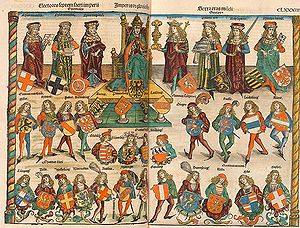
Armin Wolf (†)
A group of princes formed in the 13th century, which was solely entitled to elect the German king until 1806. In the original form, there were seven electors, three of them spiritual (archbishops of Mainz, Trier, Cologne) and four secular (Bohemia, Palatine, Saxony, Brandenburg). Research discusses different theories why this group of all people received the right to elect the king (determination by the pope, holders of arch offices, determination in the Sachsenspiegel (Saxon Mirror), inheritance law, imperial law). The Golden Bull of 1356, later referred to as the "Basic Law of the Holy Roman Empire", laid down the number of electors and their rights. More electors were not created until 1648, 1689/1708 and 1803. The Golden Bull secured the position of elector for the House of Wittelsbach's Palatine line. It remained there until 1623 and then passed to the Bavarian line. A new position of elector was granted to the Palatine House of Wittelsbach in 1648.
Definition
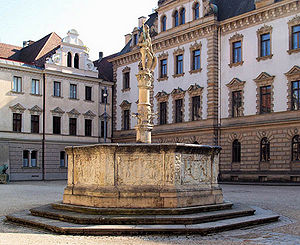
The Empire's seven electors ("principes electores imperii") were three spiritual princes (the archbishops of Mainz, Trier and Cologne) and four secular princes (the King of Bohemia, the Count Palatine of the Rhine, the Duke of Saxony and the Margrave of Brandenburg). They had the exclusive right to elect the Roman-German king and later Emperor.
The electors did not exist in the first centuries of the East Franconian, then German kingdom. Back then the kings were proclaimed by a larger group, mainly by the princes. But for a long time it has not been passed down to us in detail who belonged to this group or how they defined themselves. Only on the occasion of the dual election between the Staufer dynasty and the House of Welf in 1198/99 a total of 61 electors of the king is attested in documents (cf. "Inheritance law theory" below).
First Appearance 1298
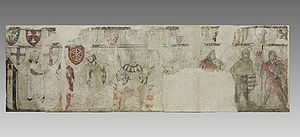
A century later, on 24 July 1298, the seven electors mentioned above came together for the first time in Mainz "for a salutary reform of the Constitution of the Holy Empire" ("pro salubri sacri status imperii reformacione"). This was preceded by the deposition of King Adolf of Nassau (king 1292-1298) by numerous followers of Albrecht of Austria (king 1298-1308) on 23 June and the latter's first election as king in Mainz. Adolf died in the battle between the two kings on 2 July 1298. Now his former followers and opponents agreed on 24 July 1298 in Mainz to elect Albrecht of Austria as king three days later in Frankfurt. Regarding his election in Frankfurt on 28 July 1298 they drew the first document in Frankfurt, which all seven electors issued together and certified with their seven seals (Q 75; Q refers to the source appendix in: Wolf, Die Entstehung des Kurfürstenkollegs). With Rudolf, Count Palatine of the Rhine and Duke of Bavaria (ruled 1294-1317), a man from the House of Wittelsbach also belonged to this electoral union. The King of Bohemia only sent a representative on this occasion. All seven electors met for the first time in person on the first court (Hoftag) convened by the newly elected king in November 1298 in Nuremberg. This had "never happened since time immemorial" (Johann von Victring; Q 81).
Ludwig der Bayer (count palatine and duke of Bavaria 1294-1347, king 1314, Emperor 1328) also called the electors of the king a "collegium" for the first time in a document of 1298 (Q 73). In the same year, the electors of the king were first given the German title "kurfursten" - in fact in three different places (Q 76, 77, 79). In the Imperial Peace of 1298, the "fursten" from the previous document were replaced by "kurfursten (prince electors)". Soon afterwards the first representative picture of the king with the seven electors was produced in Zurich (probably in 1299 on the occasion of King Albrecht's visit).
Origin of the Electoral College
The origin of the right to elect the king and the electoral college was long regarded as an "unsolvable constitutional-historical problem" (Lintzel, Entstehung, 47). Various theories have been proposed.
Curial Theory
Pope Innocent III (ruled 1198-1216) declared in 1202 in the "Venerabilem" bull that the Apostolic See granted the right "to elect the king to be promoted to Emperor to those princes who are entitled by right and according to old custom". This referred to the numerous German princes (translatio imperii in Germanos, Q 15). However, the bull did not determine who was a German prince in detail. "Venerabilem" was added to the decretals of Pope Gregory IX (ruled 1227-1241) in slightly revised form in 1234 (Q 31) and became part of canon law.
Richard of Cornwall (died 1272) and Alfonso of Castile (died 1284), elected in two competing elections in 1257 for German kings, conducted a trial for their recognition before the papal Curia. During this lawsuit, the electors of both hostile parties were put on record. Their names were compiled by the canonist Henry of Segusio (Henricus de Segusio, as bishop of Ostia named Hostiensis, died 1271) around 1263, before 1265 in a gloss to the "Venerabilem" (Q 51)in a single list, which named seven princes, who later became the seven electors. Pope Gregory X (ruled 1271-76) probably requested these seven princes to elect a new king after Richard's death (a document regarding this has not been preserved though). Six of the seven elected Rudolf of Habsburg in 1273 (ruled as Roman-German king 1273-1291). The Curia did not accept the King of Bohemia's protest. All seven voted together and with the exclusion of others for the first time in 1298 in the election of Albrecht of Austria (Q 75).
Pope Boniface VIII (ruled 1294-1303) made a statement in 1300, in which he referred to the "Venerabilem" bull (1202 and 1234) but deviated from it in two important formulations. The right to elect the king to be elevated to Emperor was now not only generally granted to German princes ("ad quos de iure ac antiqua consuetudine noscitur pertinere"), but also to "certain" princes ("certis principibus"). The Curia not only recognised this right ("recognoscimus") but also granted it ("concessit"). King Albrecht, who wanted to free himself from the stigma of the murder of a king (Adolf von Nassau) and hoped to be crowned Emperor by the pope, expressly recognised this in 1303.
However, the electors did not confirm this claim. According to their own self-understanding, as they claimed in the Electoral Union of Rhens in 1338, they did not obtain their rights from the church but "from the Empire". Even the Golden Bull of 1356 did not attribute the appointment of the electors to the Curia. As late as 1623, the Duke of Bavaria refused to have his elevation to Elector confirmed by the Pope. Conversely, the Pope protested against the creation of an eighth electorate for the Wittelsbach Count Palatine, which happenend without his consent in 1648 by the Peace of Westphalia. The curial theory was a papal claim but not generally accepted. One effect of the Curia, however, lay in the recognition of the election of the future Emperor by the Germans (i. e. their princes) in 1202 and in the non-recognition of the Staufer and their followers since 1245.
Disinterest Theory
According to Martin Lintzel (1901-1955), the originally high number of the king's electors decreased in the course of the 13th century due to a growing lack of interest in the election of the king, so that only the seven electors remained in the end. This disinterest may have played a role in reducing the number of spiritual electors of the king, especially since many of them remained loyal to the Staufer for a long time and after the ban on Emperor Friedrich II (ruled 1211-1250) and his followers in 1245 and had no interest in electing an anti-king. However, the non-inclusion of the secular princes of Bavaria, Austria and Saxony-Lauenburg in the later electoral college met with their protest and was by no means due to a lack of interest.
Arch Office Theory (Erzämtertheorie)
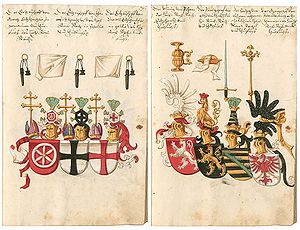
The Arch Office theory can be found for the first time in the only manuscript of the Annales Stadenses dating from the 14th century: "The Count Palatine elects because (quia) he is the steward, the Duke of Saxony because he is the marshal, the Margrave of Brandenburg because he is the chamberlain. The King of Bohemia, who is the imperial cupbearer, has no vote because he is not German." (Q 80) The passage is indisputably dependent on the Sachsenspiegel (Landrecht, III 57,2) (Q 58), in which, however, the causal link (quia/because) is still missing. Nevertheless, for a long time research (against Mitteis) concluded from the Sachsenspiegel passage that since the 13th century the four lay princes had been entitled to elect because they had held certain court offices, which were later called Arch Offices" (Krieger, König, 67f.).
According to Egon Boshof (born 1937), the theory of the Arch Offices was established by Archbishop Adolf of Cologne (ruled 1193-1205, 1210-1216) and his supporters in the dual election of the Staufer dynasty and the house of Welf (1198) in order to support the weak legal position of the Welf party. But why would this party grant the right of the first votes to Trier, Bohemia, Saxony and Brandenburg, who were on the Staufer dynasty’s side? The Arch Office theory only shifts the problem of the origin of the electoral college but does not solve it. Even if the election rights really were beased on the Arch Offices, the second question would logically arise as to why certain princes held Arch Offices but others did not.
Before 1198 the offices had lain in changing hands of various distinguished princes present at court (documents: Wolf, Verwandtschaft, 114). In the first half of the 13th century, there is no evidence of any office being exercised. All seven later electors were associated with the (Arch)offices in literature for the first time in the chronicle by papal poenitentiary Martin of Opava (1268/71) (Q 52). During Rudolf of Habsburg's reign, Brandenburg, Saxony and Bohemia (not Palatine yet) began to occasionally hold the titles of Chamberlain, Marshal and Cupbearer of the Roman Empire since 1277/91. When the seven electors came together for the election of Albrecht in 1298 and issued a document in all of their names for the first time, they did not bear these titles though. A few months later, on the first court (Hoftag) convened by King Albrecht in Nuremberg, they were officially awarded the (arch)offices and exercised them for the first time in this traditional distribution. Thus they made their position impressively visible to the general public. The Arch Offices had considerable importance in this effect on the public. They were not the legal arguments for the king's election but they were honourable attributes. Holding these offices followed the right to elect, not the other way around!
Usurpation Theory
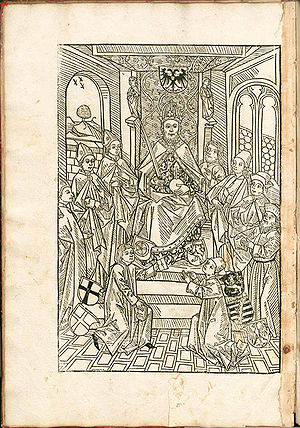
According to Heinz Thomas (1935-2024), King Wenceslas I of Bohemia (ruled 1230-53) "invented" the Arch Office theory when in 1239 he planned the elevation of a Danish prince to king against the Staufer dynasty in alliance with Palatine-Bavaria, Brandenburg and Saxony (in vain). The poem of praise by Reinmar von Zweter (ca. 1200-ca. 1260) on "künec Erich von Tenemarken" (ruled 1241-50) used by Thomas (1992) has hardly anything to do with this plan, because the talk was not about Erich's candidacy in 1239, but that of his brother Abel. Furthermore, the anonymous "Kurfürstenspruch" (Q 77) used by Thomas (1992) is rather to be dated around 1298, according to the context in the only manuscript (Wolf, Verwandtschaft, 860-866). Nevertheless, the usurpation theory cannot be completely rejected. The unification of the seven electors and the election of Albrecht of Austria in 1298 had a usurpatory character because of the deposition and killing of King Adolf before. However, the election of the son of the preceding king was justifiable under the law of succession.
Development Theory
According to Franz-Reiner Erkens (born 1952), the Arch Office theory, for which there is no contemporary evidence, is indeed an "appealing presumption", but "not provable" (Deuten, 331). Erkens starts from the premise that "the electoral college in the 13th century was not created by a special legal act, but by a gradual development which various influences had an effect on" (Kurfürsten, 93). One of the most important factors was the Sachsenspiegel.
Sachsenspiegel (Saxon Mirror)
This German legal book written around 1220/35 by Eike of Repgow (ext. 1209-1233) states: "The Germans should elect the king by right." In addition to this "1st king's election paragraph" (Sachsenspiegel Landrecht III 52, 1 = Q 30), the "2nd king's election paragraph" (III 57, 2 = Q 58) names six of the seven later electors as the "first to vote". Palatine, Saxony and Brandenburg have the election and an office, the three spiritual princes have the right to elect but no office, the Bohemian does in fact have an office but not the right to elect (Q 58). The Sachsenspiegel therefore does not prove the equivalence of election right and office and certainly not causality. "For Eike, the Arch Office by no means gave the legal argument for the first election right" (Mitteis, Königswahl, 173). The exclusivity of election rights is also missing in the Sachsenspiegel, because after the first electoral group all princes of the kingdom vote. The number seven and the word Elector (Kurfürst) do not appear.
For most researchers, Eike did not create the Sachsenspiegel's king's election theory but "merely picked up on it" (Erkens, Kurfürsten, 88). However, there is no proof pre-Eike for the list of the six princes "to vote first". Peter Landau (born 1935) therefore sees the "emergence of the electoral college as a result of Eike von Repgow's legal construction", which could be "explained from his reading". However, it is questionable whether Eike could change German constitutional law as a "legal inventor" (Landau, Eike von Repgow, 46, 29, 49) and whether Landrecht III 57, 2 did not reflect an already existing reality.
The dating and interpretation of the 2nd king's election paragraph is central to the emergence of the electoral college. In the past it was almost always assumed that this paragraph also originated from Eike von Repgow. Erkens 2002 and 2005, Landau 2008 and Begert 2010/2018 continue to adhere to this. However, according to Daniels 1843, Castorph 1978, Wolf 1990, 1998 and 2013, Thomas 1992, Willoweit 2005 and Assing 2010, this paragraph does not originate from Eike himself but was added to the Sachsenspiegel later. A king's election by exactly the two groups of each three princes "to vote first" mentioned there and under explicit exclusion of the Bohemian, who had been completely unchallenged as one of the electors in 1198/99, 1212, 1237 and 1257, is however only provable in the case of the election of Rudolf of Habsburg in 1273. In contrast to the undoubtedly genuine 1st king's election paragraph, the 2nd king's election paragraph with the exclusion of Bohemia is therefore anachronistic at the time of Eike. It was obviously only included in the "4th version" of the Sachsenspiegel around the time of Rudolf's election in 1273. All the later versions of the law book depend on this version (Wolf, Verwandtschaft, 105, Datierung 2020).
One weighty argument against Eike's authorship of the 2nd king's election paragraph is the fact that the six princes “to vote first" contained in it were not originally listed in the Sachsenspiegel's feudal law (text synopsis in: Wolf, Verwandtschaft, 90f.). Auctor vetus, the Latin original of Eike's Sachsenspiegel (around 1220), and the Görlitz Law Book (manuscript around 1300) only say: "Six princes who are first in the king's election" ("sex principes, qui primi sunt in eius electione") are to accompany the king to Rome to testify the legitimacy of the election to the Pope. The point of the sentence is: The princes are the first to vote. (At least) six (of them) shall testify to the election. Non-princes are not sufficient for the testimony! In fact, at least six princes had always accompanied the king to Rome before, but different ones every time. It therefore corresponded to the legal reality at the time of Eike not to name the six princes in detail. There is also no reason for which Eike himself would have included a list of six princes "to vote first" in his German version of the Sachsenspiegel. As late as 1237, that is after the composition of Eike's work, not six but eleven princes elected Konrad IV (ruled as Roman-German king 1237-1254) (Q 33). In 1247, the Pope thanked ten (partly other) princes for the election of Wilhelm of Holland (Roman-German anti-king 1247-1254, Roman-German king 1254-1256) (Q 41). In 1257 the English king, who had campaigned for the election of his brother Richard of Cornwall, knew 14 secular princes as electors in addition to the three Rhenish archbishops (Q 45). Their "long list" probably goes back to information from the Archbishop of Cologne. Outside the Sachsenspiegel, the list of six is first documented in Germany in 1274/75 in the Deutschenspiegel (German Code of Law). "To understand the assumption of a later addition to the Sachsenspiegel text is easier than to find an explanation for the assignment of precisely these princes to the Arch Offices" (Dietmar Willoweit, Deutsche Verfassungsgeschichte, 2005, 95). Auctor vetus I 12 and Landrecht III 52 of the Sachsenspiegel reflect the state of law around 1220, Landrecht III 57 the one of 1273. The latter passage obviously followed the Gloss of Hostiensis of ca. 1263/65 (Castorph, Grundlagen, 2020, 89f.).
The hypothetical pre-election group of 1198 or 1220/35, on the other hand, seems to be a rear projection of the later electors.
Law of succession Theory
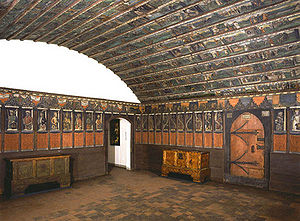
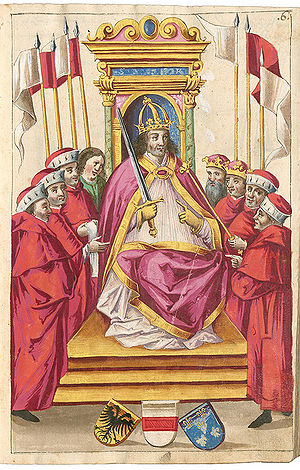
The "law of succession theory" was only developed in recent years by Armin Wolf (born 1935). It is based on the kings' and their electors' family relationships as a contemporary "new source" unnoticed up to now. It assumes that in the dual election in 1198/99 a total of 61 princes, namely 38 spiritual (31 bishops and 7 abbots) and 23 secular, are documented as electors of the king (Q 7-11). While their right to elect has not yet been fully accounted for, the law of succession theory is based on the fact that the 23 secular electors of the king in 1198/99 represented precisely those 19 dynasties which descended in female lines from at least one of the former kings, within the first six degrees of kinship, ultimately from the royal couple [Person:11854831X|Heinrich I]] (as German king 919-936) and Mathilde (895-968), within the first six degrees of kinship. This legitimised their right to elect by law of succession (Sachsenspiegel Landrecht I 3,3). The older royal dynasties (Ottonian, Salian, Rheinfelden, Süpplingenburg) had all died out in the male line but lived on in female lines (including the Wittelsbach, Welf, Andechs-Merania and Ronsberg dynasties in present-day Bavaria). Also the Staufer dynasty was just one of these 19 "royal daughter lines". The law of succession theory is based on the identity of the representatives of these dynasties with the secular princes testified as electors of the king in 1198/99: "Who had the right to inherit had the right to elect."
Originally, it were the imperial princes who were entitled to elect the king ("principes imperii, ad quos de iure spectat electio"). Their large number in 1198/99 was reduced in the course of the 13th century to the small number of the seven electors. Several dynasties of secular electors died out between 1212 and 1268, their legacy mostly fell to other dynasties of electors or to the Empire (Wolf, Verwandtschaft, 60-68). The deposition of Emperor Friedrich II by the Pope in 1245 and the fall of the Staufer dynasty had a significant impact. In 1256, the Pope sent his threat to excommunicate anyone who elected the Staufer Konradin to the three Rhenish archbishops only, who were to inform the other electors, who were not named individually. The number of participants in the king's elections declined even more after that. Only the archbishops of the three oldest metropolitan seats (Mainz, Trier and Cologne) remained among the ecclesiastical electors.
In 1257, the Archbishop of Cologne and the Count Palatine elected the brother of the King of England, Count Richard of Cornwall and Poitou, and a few weeks later the Archbishop of Trier elected King Alfonso of Castile as Roman-German king. Both parties therefore turned away from the Staufer dynasty but nevertheless took elements of inheritance law into account. They did not choose exotics, but - taking elements of law of succession into account - opted for one of the three grandchildren of King Philipp of Swabia (ruled as Roman-German King 1198-1208) in Alfons and for the closest living relative of Emperor Otto IV of Brunswick (ruled as Roman-German King 1198-1218, Emperor from 1209) in Richard. The Cologne-Palatine party claimed power of attorney for Mainz, the Trier Archbishop for Saxony, Bohemia and Brandenburg. Taken together, the two parties corresponded to the seven later electors. From this it has mostly been concluded so far that the electoral college must have been constituted before 1257. However, this assumption led to the astonishing conclusion: "However, the sources of the time during which the electoral right must have developed, say nothing about its coming into being" (Lintzel, Entstehung, 9). Could it be that we've been looking at the wrong time? Sources are available for 1298!
The law of succession theory therefore emphasises that the electors of the two opposing kings of 1257 represented just two competing parties, who had gathered in two different places and at different times, elected their own king separately, and were not yet constituted as an electoral college. The Dukes of (Lower) Lorraine-Brabant and of (Upper) Lorraine, who had not renounced their (inherited) right to elect, reached an agreement in direct negotiations with King Alfonso. Due to the canon rule of unitas actus, however, their votes could not be taken into account in the trial before the Curia. The Wettin Margrave of Meissen and Landgrave of Thuringia remained faithful to the Staufer dynasty. According to Bavarian testimonies (Annals of Salzburg, Hermann von Niederaltaich), in addition to the Count Palatine and Duke of (Upper) Bavaria, Ludwig II (ruled 1253-1294), his brother Heinrich XIII of Lower Bavaria (ruled 1253-1290) also took part in Richard's election as the second member of the Wittelsbach family. The Count Palatine testified to this in 1275 (Q 60). All this suggests that the group the king's electors was not yet constituted in 1257. Those who remained loyal to the Staufer dynasty did not elect at that time.
In 1266, the Pope again warned the German princes against electing the Staufer Konradin king; he threatened the secular electors and their descendants up to the fourth generation with the withdrawal of their right to elect (Q 50). This shows that the Pope also assumed the heredity of the secular electors’ right to elect.
In 1273 Rudolf of Habsburg was elected king by the three Rhenish archbishops, the Count Palatine, Saxony, Brandenburg, as well as by "plenty of other princes" after them, who were not named individually (Sächsische Weltchronik, Q 57, cf. Q 58). The article inserted in the Sachsenspiegel at that time (Landrecht III 57,2), which listed the six princes "to vote first" by name, corresponds to this. This passage continues: After that, "the princes of the kingdom, spiritual and lay, all vote." The Staufer grandson in female line King [Person:118590898|Ottokar of Bohemia]] (ruled 1253-1278), who had run for election himself, had his ambassador protest in vain against Rudolf's election. The Sachsenspiegel (therefore?) denied the Bohemian the right to elect and justified this with the fact "that he is not German".
After his election, Rudolf of Habsburg met the condition set and secured by his secular electors ("ypoteca cavente" as well as "receptis caucionibus") to receive the new king's daughters for marriage. Two weddings (with the Wittelsbach Count Palatine Ludwig II and the Ascanian Duke Albrecht of Saxony [ruled 1260-1298]) were celebrated in 1273 on the evening of Rudolf's coronation day in Aachen (Q 57). Legally, the king's candidacy and the electors´ marriage claim, the king's election and marriage promise, the king's coronation and the electors´ marriage to the king's daughters seem like a step-by-step business transaction. Two other weddings were celebrated in 1279, with the Wittelsbach Duke Otto III of Lower Bavaria (ruled 1290-1312) and the Ascanian Margrave of Brandenburg Otto VI der Kleine (ruled 1280-1286, died 1303), who had still been minors in 1273. As a result, the Wittelsbach and Ascanian dynasties became daughter lines (Tochterstämme) of the new king, who had founded the Empire again after the "Interregnum". They became the next to the throne and acquired hereditary claims for their direct descendants.
At the Augsburg court (Hoftag) in 1275, the King of Bohemia was proscribed and the two Wittelsbach brothers’ vote (additionally and deviating from Hostiensis) was counted together as a seventh vote for the Duchy of Bavaria. This was the first time that the number seven was mentioned as that of the king's electors in Germany (Q 60). Accordingly, the Schwabenspiegel (probably written in Augsburg) ascribed the first three ecclesiastical votes to the rhenish Archbishops and the first four secular votes to the Count Palatine, the Saxon, the Brandenburgian and the Bavarian (i.e. two Wittelsbachs) in 1275/76 (Q 61). After the Bavarian marriage had ended childlessly and King Rudolf had reconciled himself with the son of the King of Bohemia who had fallen in the war against Rudolf, the Bohemian also received one of Rudolf's daughters as his wife and the right to elect again (expressly described as hereditary) in 1289/90 (Q 65). It was determined that the office of Cupbearer was also to belong to Bohemia and "no other" (i.e. not Bavaria). Nevertheless, the young Duke and later Emperor Ludwig der Bayer demanded at the first election of King Albrecht in 1298 to belong to the college of electors of the king because of the order of descent ("ordine geniture"), but in vain (Q 73).
It was therefore King Rudolf's German sons-in-law and grandsons who came together for the first time with the three Rhenish archbishops in the later traditional composition of the seven electors at the election of Albrecht of Austria in 1298 (Q 75). These Habsburg daughter lines together with King Albrecht from the Habsburg male line, who was elected by them, formed a community of heirs to Rudolf of Habsburg. A manuscript of the Schwabenspiegel dating from around 1300 added the exclusivity: "and no one else shall elect the Emperor" (Synopsis: Wolf, Verwandtschaft, 715). The Houses of Saxe-Lauenburg, Brabant, (Upper)Lorraine and Wettin, who had also been electors of the king in former times but did not descend from king Rudolf, did not become electors at that time.
With the assassination of Albrecht of Austria in 1308 and the election of Heinrich VII of Luxembourg as king, the principle of the election among the next heirs was interrupted but the heritability of the secular electors' active right to elect the king remained intact.
The law of succession theory can explain the composition of both the large number of electors of the king in 1198/99 (representatives of the daughter lines of King Heinrich I) and the small number of electors in 1298/1356 (representatives of the daughter lines of King Rudolf of Habsburg). The law of succession theory is based on the application of the legal principles handed down in the Sachsenspiegel to the descendants of King Heinrich I (resp. Rudolf of Habsburg). These principles are its source: Nothing is lost from the descendants as long as there are legitimate descendants. First the sons inherit but if there are not any sons, the daughters (or their descendants: the daughter lines) (Landrecht I 17,1). The German (princes) shall elect the king by law (de iure) (Landrecht III 52,1). Princes shall have no other layperson other than the king as lord (Landrecht III 58:1). If there are no direct descendants, the next relatives (among the descendants of the first owner) follow, up to the sixth degree of kinship. Their right to inherit ends in the seventh degree (Landrecht I 3,3). The right to elect the king was also a right to be inherited. The Golden Bull codified it in 1356.
The law of succession, just as in the Golden Bull, only established the secular electors´ right to elect the king. However, it must be noted that the three rhenish archbishops had largely obtained their territories from the estates of childless members of the royal family ((Otto of Swabia [Duke of Swabia 973-982, Duke of Bavaria 976-982], Emperor Otto III [Roman-German King 983-1002, Emperor from 996], Emperor Heinrich II [German king 1002-1024, Emperor from 1014]) or extinct royal daughter lines (Ezzonen, Werl). The prince bishoprics kept these possessions independently of the individual archbishops and therefore also became a kind of "heir in the Empire" (Wolf, Verwandtschaft, 81).
In law of succession, by the way, it was not biological but legal ancestry that counted. Palmed off children were entitled to inherit, but the (numerous) extramarital children were not.
Simplification Theory
Helmut Assing (born 1932) also speaks of the "electoral college, which apparently constituted itself for the first time in the summer of 1298". However, he does not see the reason for this in the community of heirs after Rudolf of Habsburg but as "the result of a selection process on the basis of a simplification (Versachlichung) of the king's election law for liturgical-ritualistic, legal, political or economic reasons" (Weg, 115).
Imperial Law Theory
In a print of 1613, a law was published in which King Otto IV had supposedly determined six electors of the king in 1209. However, this alleged decree dependent on Hostiensis (ca. 1263/1265) was recognised as a forgery a long time ago. Regardless of this, the Imperial law theory has been revived in recent times: Otto IV is supposed to have stipulated six electors of the king by law at the Würzburg court (Hoftag) in 1209. At King Wilhelm's Brunswick court (Hoftag) in 1252, a further imperial law allegedly established the committee of seven by adding the Bohemian King (Alexander Begert, Entstehung, 2010). According to another opinion, the Frankfurt court (Hoftag), scheduled for 8 September 1256, decided the seven electors' sole right to elect (Karl Zeumer 1905, Wolfgang Giese 1984). The weaknesses of these theories lie in the fact that such laws have been passed down neither of 1209 nor of 1252 or 1256. It is not even certain whether the Frankfurt court (Hoftag) actually took place. It is true though, that Emperor Karl IV's (ruled as Roman-German King 1346-1378, Emperor from 1355) “Golden Bull” at the Nuremberg and Metz court (Hoftag) in 1356 codified the electoral law in an imperial law, which remained in force until 1806.
The Electors in the Golden Bull

The electoral college of 1298 was not yet secured by imperial law and was therefore still endangered. Two parties faced each other in the dual election in 1314: Habsburg Austria, Wittelsbach Palatinate and Saxony-Wittenberg elected Friedrich of Austria (died 1330), while the Wittelsbach of Bavaria, Luxembourg-Bohemia and Saxony-Lauenburg elected Ludwig der Bayer. The grandson of Rudolf of Habsburg, Friedrich of Austria (ruled as Roman-German King 1314-1330) was defeated by Ludwig der Bayer (excluded in 1298) in the Battle of Mühldorf am Inn in 1322. Karl of Luxembourg was proclaimed king against the latter in 1346. The later Emperor did not consider either the Habsburgs or the Bavarians in the Golden Bull of 1356.
The seven electors' exclusive right to elect the king was officially recorded in an imperial law there. The Golden Bull specifically confirmed the rights to elect held by the King of Bohemia (contrary to the Sachsenspiegel), the Palatine but not the Bavarian line of the Wittelsbachs (contrary to the older manuscripts of the Schwabenspiegel) and the Wittenberg but not the Lauenburg line of the Dukes of Saxony (which was older, but not descended from Rudolf of Habsburg). This affirmed the victory of the Habsburg daughter lines against the Habsburg male line.
Articles VII "About the Succession of the Electors" and XXV codified the heritability of the secular electors' right to elect the king. According to this, the right, vote and power to such an election ("ius, vox et potestas electionis huiusmodi") derived from birth and succession. It is the oldest German law of succession put in writing, but it reflected a long practised habit. The secular electors recognised in the Golden Bull already looked back on four or five generations of their ancestors as electors of the king since 1198. The Golden Bull called the electors a union ("unio") and a community of heirs ("consortium"). "The Empire was an electoral kingdom and a heirdom of electors" (Wolf, Entstehung, 99).
The Golden Bull also determined that the position of elector would only appertain to the primogenital line of a dynasty of electors of the king in future. The Wittelsbach house contract of Pavia in 1329 had still provided that the position of elector should alternate between the House of Wittelsbach's Palatine and Bavarian line.
Later Changes to the Electoral College
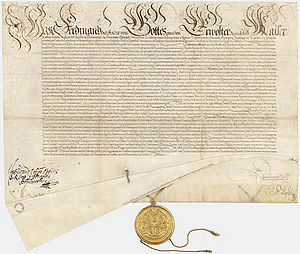
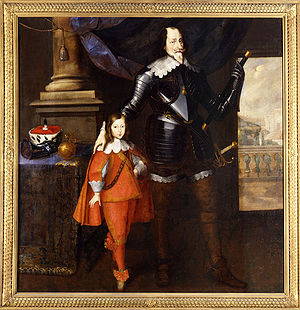
After the Ascanian Margraves died out, King Ludwig der Bayer conferred Brandenburg with the right to elect on his son Ludwig V der Brandenburger (died 1361) in 1324. Emperor Karl IV acquired the Brandenburg right to elect from the latter´s childless brother and successor Otto (ruled 1351-1373, died 1379) in 1378 and successively granted it to his sons Wenzel (ruled 1376-1400) in 1373 and Sigmund (ruled as Roman-German king 1410-1437) in 1378. Here, too, the electoral rights were given to the Emperor's closest relatives.
In 1410/11 at the competitive elections of Sigmund of Luxembourg and Jost of Moravia (elected Roman-German King 1410-1411) there was a dispute about who held the Brandenburg vote, because it was undecided whether a right to vote could be transferred by pledging the adherent territory. There was therefore once again a double kingship, which only ended with the death of Jost in 1411. King Sigmund, the last representative of the Luxembourg male line, had just one minor daughter and no male blood relatives in the female line, either. In 1415 he sold the right to elect, which was connected to the Margraviate of Brandenburg and he had held himself, to the Hohenzollern Burgrave Friedrich VI of Nuremberg (reigned 1397-1429). When the Ascanian Dukes of Saxony-Wittenberg died out, he gave their right to elect to the Wettin Margrave Friedrich IV of Meissen (ruled 1407-1428) in 1423. Both the Hohenzollern and the Wettin represented the daughter lines of Ludwig der Bayer, the last Emperor before the Luxembourgers. Both dynasties retained the position of elector until the end of the Old Empire in 1806.
However, the Emperor withdrew the Saxon electorate from Duke Johann Friedrich I of Saxony (Saxon elector 1532-1547), who was defeated by him in the Schmalkaldic War in 1547, and transferred it to the latter's cousin Moritz (ruled as Saxon elector 1547-1553). Count Palatine Friedrich V (reigned 1610-1623), who also rebelled against the Emperor, lost his electorate to his Bavarian cousin Maximilian I (reigned 1597-1651) after his defeat at the White Mountain near Prague and his proscription in 1623. In both cases, the electoral rights remained in the Houses of Wettin and Wittelsbach. Even now, they were apparently regarded as an inherited privilege of a dynasty. In the Peace of Westphalia (Osnabrück Article IV § 5), the House of Wittelsbach received an eighth electorate for the Counts Palatine in addition to the Bavarian one in 1648.
The House of Welf, which had already exercised the right to elect the king in 1198/99, but had lost it in 1235 with the renunciation of the Duchy of Saxony, received a ninth electorate for the Duchy of Brunswick-Lüneburg (line of Hanover) after the acquisition of the Duchy of Saxe-Lauenburg in 1689/1708. At the same time, the Bohemian electorate, which had only been exercised to a limited extent during the time of the Bohemian kings from the House of Jagiellon was revived in the hands of the Habsburg imperial family.
Max Emanuel of Bavaria (ruled 1679-1726), who had opposed the Emperor during the War of Spanish Succession in 1705, lost the electorate but received it back in the peace treaty in 1714. Since the House of Wittelsbach temporarily owned the Archdiocese of Cologne, they held two electoral votes since 1583, even three from 1648 to 1761 (Bavaria, Palatinate, Cologne), and with Trier from 1716 to 1729 and Mainz from 1729 to 1732 even four electoral votes. It was only with the union of the House of Wittelsbach in 1724 that the Wittelsbach lines, which had long been enemies, found a common policy. This favoured the election of Karl VII (ruled 1726-1745) from Bavaria as Emperor in 1742, after the Habsburg male line had died out in 1740. When Count Palatine Karl Theodor (ruled 1742-1799) inherited the Duchy of Bavaria in 1777, both Wittelsbach electorates were reunited into a single one in fulfilment of a provision in the Peace of Westphalia (Osnabrück Article IV § 9), which reduced the number of electors to eight.
End of the Electors
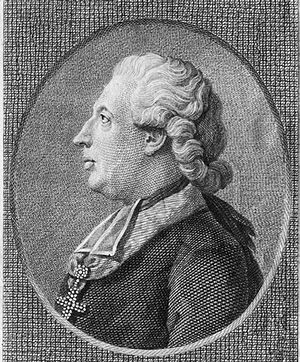
The electors elected an Emperor for the last time in 1792. After the Empire had lost its territories on the left bank of the Rhine to France, the Electorate of Cologne and the Electorate of Trier ceased to exist in 1803 due to the Final Recess of the Imperial Deputation (Reichsdeputationshauptschluss), while the Electorate of Mainz was transferred to Regensburg. The House of Habsburg received a second electorate for Salzburg (from 1805 Würzburg). Baden (Zähringer), Württemberg and Hesse-Kassel (House of Brabant) received new electorates. As a result, there were ten electors at the fall of the Old Empire in 1806.
In 1806, Napoleon Bonaparte (1769-1821, Emperor of the French 1804-1814) made the former Archbishop of Mainz Karl Theodor von Dalberg (1744-1817) the prince primate of the Rhenish Federation and its members, the former electors of Bavaria, Saxony and Württemberg into kingdoms, Baden and Würzburg into grand duchies. Bohemia had been a kingdom since ancient times (1198), Brandenburg now went to the Kingdom of Prussia, which until then had only consisted of the provinces of East and West Prussia outside the Empire. Of the expropriated electorates, Hesse-Kassel, which had regained its territory in 1813, continued to call itself an "electoral principality" until it was annexed by Prussia in 1866, while Hanover became a kingdom in 1814 on the grounds that electors held royal rank. Hanover retained its electoral coat of arms (the imperial crown, in the escutcheon!) until it was annexed by Prussia in 1866, even in the Hanoverian quarter of the royal arms of Great Britain and Ireland until 1837!
References
- Helmut Assing, Der Weg der sächsischen und brandenburgischen Askanier zur Kurwürde, in: Eckhardt Opitz (Hg.), Askanier-Studien der Lauenburgischen Akademie, Bochum 2010, 71-118.
- Winfried Becker, Der Kurfürstenrat. Grundzüge seiner Entwicklung in der Reichsverfassung und seine Stellung im Westfälischen Friedenskongreß, Münster 1973.
- Alexander Begert, Die Entstehung und Entwicklung des Kurkollegs. Von den Anfängen bis zum frühen 15. Jahrhundert (Schriften zur Verfassungsgeschichte 81), Berlin 2010. (Vgl. die Besprechungen von Franz-Reiner Erkens, in: Mitteilungen des Instituts für Österreichische Geschichtsforschung 119 [2011], 376-381, und von Armin Wolf, Wie kamen die Kurfürsten zu ihrem Wahlrecht? Eine Stellungnahme zu dem Buch von Alexander Begert, in: Zeitschrift der Savigny-Stiftung für Rechtsgeschichte, Germanistische Abteilung 129 [2012], 340-363.)
- Alexander Begert, Von Tochterstämmen, Interpolationen und Konspirationen: Anmerkungen zu den Thesen von Armin Wolf, in: Rheinische Vierteljahrsblätter 82 (2018), 186-199.
- Egon Boshof, Erstkurrecht und Erzämtertheorie im Sachsenspiegel, in: Theodor Schieder (Hg.), Beiträge zur Geschichte des mittelalterlichen deutschen Königtums (Historische Zeitschrift. Beiheft. Neue Folge 2), München 1973, 84-121.
- Bernward Castorph, Die Ausbildung des römischen Königswahlrechtes. Studien zur Wirkungsgeschichte des Dekretale "Venerabilem", Göttingen 1978.
- Bernward Castorph, Die rechtlichen Grundlagen der römisch-deutschen Königswahl seit 1198: Vom Dekretale Venerabilem zur Goldenen Bulle, Borsdorf 2018.
- Franz-Reiner Erkens, Kurfürsten und Königswahl. Zu neuen Theorien über den Königswahlparagraphen im Sachsenspiegel und die Entstehung des Kurfürstenkollegiums (Monumenta Germaniae Historica. Studien und Texte 30), Hannover 2002. [dazu Rezension von Armin Wolf, in: Zeitschrift für Rechtsgeschichte. Germanistische Abteilung 120 (2003), 535-548]
- Frank-Reiner Erkens, Vom Historischen Deuten und Verstehen. Noch einmal zu einer neuen Theorie über die Entstehung des Kurkollegiums, in: Zeitschrift der Savigny-Stiftung für Rechtsgeschichte. Germanistische Abteilung 122 (2005), 327-351.
- Axel Gotthard, Säulen des Reiches. Die Kurfürsten im frühneuzeitlichen Reichsverband (Historische Studien 457), Husum 1999.
- Eduard Hlawitschka, Das Kurfürstenkollegium – ein Ergebnis mittelalterlichen Erbrechtsdenkens?, in: Deutsches Archiv 70 (2014 erschienen 2015), 521-539. (Vgl. dazu Wolf 2017.)
- Bernd Kannowski, The impact of lineage and family connections on succession in medieval Germany’s elective kingdom, in: Making and breaking the rules: Succession in medieval ‚Europe c. 1000-c. 1600 (Histoire de famille: La parenté au Moyen Âge 9), Turnhout 2009.
- Karl-Friedrich Krieger, König, Reich und Reichsreform im Spätmittelalter (Enzyklopädie deutscher Geschichte 14), München 1992.
- Peter Landau, Eike von Repgow und die Königswahl im Sachsenspiegel, in: Zeitschrift der Savigny-Stiftung für Rechtsgeschichte. Germanistische Abteilung 125 (2008), 18-49.
- Martin Lintzel, Die Entstehung des Kurfürstenkollegs, 1952, Sonderausgabe Darmstadt 1957.
- Heinrich Mitteis, Die deutsche Königswahl. Ihre Rechtsgrundlagen bis zur Goldenen Bulle, Brünn/München 2. Auflage 1944.
- Heinz Thomas, König Wenzel I., Reinmar von Zweter und der Ursprung des Kurfürstentums im Jahre 1239, in: Hubert Mordek (Hg.), Aus Archiven und Bibliotheken. Festschrift für Raymund Kottje zum 65. Geburtstag (Freiburger Beiträge zur mittelalterlichen Geschichte 3), Frankfurt am Main 1992, 347-372.
- Armin Wolf, Die Entstehung des Kurfürstenkollegs 1198-1298. Zur 700-jährigen Wiederkehr der ersten Vereinigung der sieben Kurfürsten (Historisches Seminar. Neue Folge 11), Idstein 2. bearbeitete Auflage 2000.
- Armin Wolf (Hg.), Königliche Tochterstämme, Königswähler und Kurfürsten (Studien zur europäischen Rechtsgeschichte 152), Frankfurt am Main 2002.
- Armin Wolf, Verwandtschaft – Erbrecht – Königswahlen. Sieben neue und 26 aktualisierte Beiträge mit 192 Tafeln, Synopsen, Landkarten und Abbildungen und einem Geleitwort von Eckart Henning. 2 Bände (Studien zur europäischen Rechtsgeschichte 283/1-2), Frankfurt am Main 2013.
- Armin Wolf, Die Erbrechtliche Theorie zur Entstehung des Kurfürstenkollegs, Zeitschrift der Savigny-Stiftung für Rechtsgeschichte, Germanistische Abteilung 134 (2017) 260-287.
- Armin Wolf, Die Datierung von Sachsenspiegel Landrecht III 57,2 und die Entstehung des Kurfürstenkollegs, Zeitschrift der Savigny-Stiftung für Rechtsgeschichte, Germanistische Abteilung 137 (2020) 421-451.
- Karl Zeumer, Die böhmische und die bayrische Kur im 13. Jahrhundert, in: Historische Zeitschrift 94 (1905), 209-250.
Sources
- Mario Krammer (Hg.), Quellen zur Geschichte der deutschen Königswahl und des Kurfürstenkollegs (Quellensammlung zur deutschen Geschichte), Leipzig 1911-1912 (ND Hildesheim 1972).
- Bernhard Schimmelpfennig (Bearb.), Die deutsche Königswahl im 13. Jahrhundert. 2 Bände (Historische Texte. Mittelalter 9-10), Göttingen 1968.
- Armin Wolf, Die Entstehung des Kurfürstenkollegs 1198-1298 (Historisches Seminar. Neue Folge 11), Idstein 1998, 2. bearbeitete Auflage 2000, Sources latin-german, 102-194.
Further Research
Alternative titles!
Cite
Armin Wolf, Electors, published 9 May 2011, english version published 26 February 2020 ; in: Historisches Lexikon Bayerns, URL: <https://www.historisches-lexikon-bayerns.de/Lexikon/EN:Electors> (20.12.2025)
